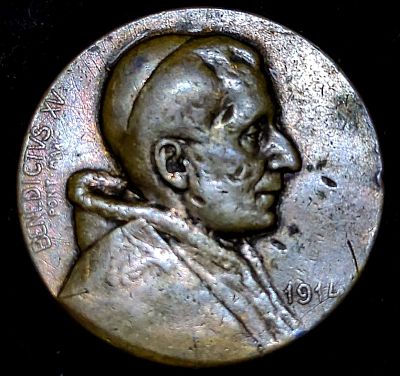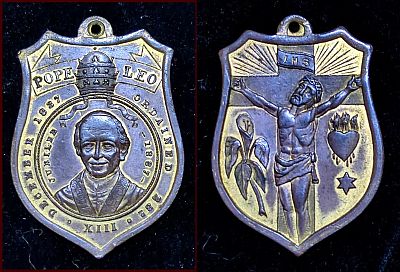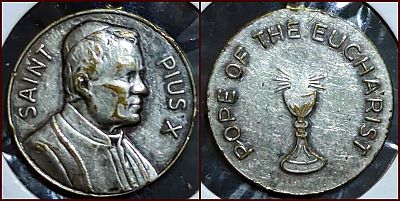Between the Papal States and the Vatican

We’ve looked at the last coins issued by the Papal States up to 1870, and the first coins issued by Vatican City State from 1929, but is there anything numismatically from the Holy See in between? Yes! (Otherwise this would be a very short post).
There were five popes who had all or part of their papacy, between the dissolution of the Papal States in 1870 and the creation of the Vatican City State in 1929. They were:
- Blessed Pius IX (1846-78)
- Leo XIII (1878-1903)
- St. Pius X (1903-14)
- Benedict XV (1914-22)
- Pius XI (1922-39)
Pius IX had coins issued under the Papal States from 1846 – 1870. Piux XI had coins issued under Vatican City from 1929 – 1939. So that leaves Leo XIII, Pius X and Benedict XV.
There were some pattern 2 and 5 Lire pieces issued with Leo XIII’s portrait. I have linked to that article previously in the post on the last Papal States coins. But for the rest of us, the most accessible pieces are medallions issued for the popes.
Pictured above is Pope Benedict XV from a medallion issued the year he took up the papacy, 1914.
It is easy to think of the pope as removed from worldly events. In the case of Benedict XV, his papacy commenced right at the outbreak of WWI. Declaring the war “The suicide of civilized Europe”, Benedict XV declared the Vatican neutral, and attempted to mediate peace on both sides. Both sides rejected this and he dedicated his efforts to humanitarian aid. This included attending prisoners of war, mediating the exchange of wounded soldiers from both sides and food deliveries to needy populations. After the war, he re-established and repaired the difficult relations with France. He also improved relations with Italy.
He created the Code of Canon Law with Eugenio Pacelli (the future Pope Pius XII) and cardinal Pietro Gasparri. This collated and organised all of the various laws and decrees which had been issued by popes, councils, and Roman Congregations. This is considered to have stimulated religious life and activities throughout the Church.
Benedict XV revitalised Catholic missions around the world, which had been damaged by the war, an effort for which he is known as “The Pope of Missions”. Pope Leo’s papal motto was Psalm 71.1: “In you, O Lord, I take refuge; let me never be put to shame.”

A number of medallions were issued under Pope Benedict XV, so this is definitely an area a collector can explore. It can fill some gap left by the lack of coins issued under this pope.
This medallion issued in 1914, commemorates the Holy Family (Jesus, and his parents Mary and Joseph). As well as picturing the family, the text around the edge reads: “IN IIS QVAE PATRIS MEI SVNT OPORTET ME ESSE”. This translates to: “I must be about my Father’s business”. The text is from the bible, from Luke 2:49. This is when the boy Jesus amazes the scholars:
41 His parents went to Jerusalem every year at the Feast of the Passover. 42 And when He was twelve years old, they went up to Jerusalem according to the custom of the feast. 43 When they had finished the days, as they returned, the Boy Jesus lingered behind in Jerusalem. And [a]Joseph and His mother did not know it; 44 but supposing Him to have been in the company, they went a day’s journey, and sought Him among their relatives and acquaintances. 45 So when they did not find Him, they returned to Jerusalem, seeking Him. 46 Now so it was that after three days they found Him in the temple, sitting in the midst of the teachers, both listening to them and asking them questions. 47 And all who heard Him were astonished at His understanding and answers. 48 So when they saw Him, they were amazed; and His mother said to Him, “Son, why have You done this to us? Look, Your father and I have sought You anxiously.” 49 And He said to them, “Why did you seek Me? Did you not know that I must be about My Father’s business?”
There are many medallions issued under many popes, certainly most of the popes in the last few centuries. Since we are looking at the period between the Papal States and the Vatican, here are medallions from the other two Popes who served solely during this period:

This impressive shield-shaped medallion commemorates the Jubilee of Pope Leo XIII’s ordination – that is, 50 years since he first took vows as a priest. The reverse features Jesus on the cross, Below and either side are a lily, and the “Immaculate Heart” above a star, possibly a star of david.

This medallion was issued for Saint Pius X. Because it designates him “Saint”, it was acutally issued in at least 1954, when he was canonized as such. Pope Pius X was known as the Pope of the Eucharist. Pius X frequently extolled the reception of Holy Communion as the “shortest and safest way to get to heaven.” Despite the conventions of his time, he determined that Christ never meant his Body to be reserved for adults, forbidden to the children he loved so much.


Leave a Reply